These Sample papers are part of CBSE Sample Papers for Class 12 Biology. Here we have given CBSE Sample Papers for Class 12 Biology Paper 1.
CBSE Sample Papers for Class 12 Biology Paper 1
| Board | CBSE |
| Class | XII |
| Subject | Biology |
| Sample Paper Set | Paper 1 |
| Category | CBSE Sample Papers |
Students who are going to appear for CBSE Class 12 Examinations are advised to practice the CBSE sample papers given here which is designed as per the latest Syllabus and marking scheme as prescribed by the CBSE is given here. Paper 1 of Solved CBSE Sample Paper for Class 12 Biology is given below with free PDF download solutions.
Time Allowed: 3 hours
Maximum Marks: 80
General Instructions:
- There are total 26 questions and five sections in the question paper. All questions are compulsory.
- Section A contains question number 1 to 5, Very Short Answer Type Questions of one mark each.
- Section B contains question number 6 to 10, Short Answer Type Questions of two marks each.
- Section C contains question number 11 to 22, Short Answer Type Questions of three marks each.
- Section D contains question number 23, Value Based Question of four mark.
- Section E contains question number 24 to 26, Long Answer Type Questions of five marks each.
- There is no overall choice in the question paper, however, an internal choice is provided in one question of two marks, one question of three marks and all three questions of five marks. An examiner is to attempt any one of the question out of the two given in the question paper with the same question number.
- No. of printed pages are three.
SECTION-A
Question 1.
Recently chikungunya cases were reported from various parts of the country. Name the vector responsible for it.
Question 2.
Why cashew is referred to as false fruit?
Question 3.
Name two animals that have become extinct due to over-exploitation.
Question 4.
What forms the backbone of a polynucleotide strand of a nucleic acid?
Question 5.
How is the presence of cyanobacteria in the paddy fields beneficial to rice crop?
SECTION-B
Question 6.
Why should a bisexual flower be emasculated and then bagged prior to artificial pollination in hybridisation programmes?
Question 7.
How does CuT act as an effective contraceptive for human females?
Question 8.
How and why is the bacterium, Thermus aquaticus, useful in rDNA technology?
Question 9.
Differentiate between predation and competition.
Question 10
Highlight any four advantages of genetically modified or transgenic animals.
SECTION-C
Question 11.
Draw a diagram of a mature embryo of grass and label six parts in it.
OR
Describe the structure of a microsporangium of an angiosperm along with its diagram.
Question 12.
Who proposed chromosome theory of inheritance? Point structure of Microsporangium
out any two similarities between the behaviour of genes and that of chromosomes.
Question 13.
A person is suffering from Amoebiasis. Mention the pathogen that causes it and one organ of the body that gets affected. Give three symptoms and one mode of its transmission.
Question 14.
How do organisms manage with the stressful conditions prevailing in their habitat for short duration? Explain with the help of one example each.
Question 15.
Mention three uses of PCR in molecular diagnostics.
Question 16.
Explain the three ways in which natural selection operates on different traits in nature.
Question 17.
Explain the antibiotics resistance observed in bacteria in light of Darwinian selection theory.
Question 18.
What is the cause of adenosine deaminase deficiency in a person? What is the importance of this enzyme? Why is it that even after infusion of genetically engineered lymphocytes into the patient suffering from ADA deficiency, the cure is not permanent?
Question 19.
(a) What is the objective of Water Act?
(b) Mention any four problems caused due to deforestation.
Question 20.
Draw well labelled diagram of a magnified view of seminiferous tubule.
Question 21.
(a) List two essential roles of ribosomes during translation.
(b) Who discovered nuclei acid? What was it called then?
Question 22.
Fill in the spaces a, b and c in the table showing certain events and their sites in human
(male / female) reproductive system
| Event | Site |
| Release of first polar body | a |
| Spermiogenesis | b |
| Fertilisation | c |
SECTION-D
Question 23.
In many villages, people do not go for vaccination/immunization because of some fear or religious beliefs; they feel they are healthy and they do not have the disease.
- How can we explain to them that vaccination will help to prevent the diseases?
- How can this idea be made to reach them?
SECTION-E
Question 24.
(a) What are
- introns, and
- exons?
(b) Represent schematically the steps in transcription in Eukaryotes.
OR
(a) Expand BAC and YAC.
(b) What is a promoter in a transcription unit?
(c) Differentiate between template strand and coding strand.
Question 25.
(a) What is meant by contact inhibition?
(b) Why is using tobacco in any form injurious to health? Explain.
(c) Why do sports persons often fall a victim to cocaine addiction?
OR
How are morphological and biochemical/’physiological characteristics of plants associated with resistance to certain pests? Explain with the examples
Question 26.
(a) Why pollen grains are known as living fossils?
(b) Study the population growth curves in the graph given below and answer the questions which follow:
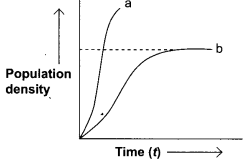
- Identify the growth curves ‘a’ and ‘b’
- Which one of them is considered a more realistic one and why?
- If \(\cfrac { dN }{ dt } =rN\left( \cfrac { K-N }{ K } \right) \) is the equation of one of the
growth curves, what does K stands for? - What is symbolized by N?
OR
(a) Name any two human activities that influence carbon cycle.
(b) Describe the particular type of agriculture which is also responsible for deforestation.
Answers
SECTION-A
Answer 1.
Vector responsible for chikungunya is Aedes aegyptii.
Answer 2.
Cashew is referred to as false fruit because the thalamus also contributes to the fruit formation.
Answer 3.
Two animals that have become extinct due to over-exploitation are:
- Dodo bird
- Caspian Bali (species of Tiger)
- Quagya (Any two)
Answer 4.
Phosphodiester linkage forms the backbone of a polynucleotide strand of a nucleic acid.
Answer 5.
The presence of cyanobacteria in the paddy fields is beneficial to rice crop because these bacteria have the property of nitrogen fixation due to the presence of heterocysts (nitrogen fixing cells).
SECTION-B
Answer 6.
A bisexual flower is emasculated to prevent self pollination and then bagged to further prevent its stigma from contamination by unwanted pollen. This is all done to get the desired result in the artificial hybridisation.
Answer 7.
CuT acts as an effective contraceptive for human females due to the following reasons:
- It releases Cu ions which suppresses sperm motility.
- Cu ions also reduces the fertilising capacity of the sperms.
Answer 8.
In PCR reaction, in the process of repeated DNA replication, the segment of DNA is amplified to approximately 1 billion time which is achieved by a thermostable DNA polymerase isolated from bacterium Thermus aquaticus.
The bacterium Thermus aquaticus (Taq) is useful in rDNA technology because it contains thermostable enzyme – DNA polymer as (Taq-DNA polymerase) which can withstand high temperature.
Answer 9.
| Predation | Competition |
| It is an interaction between the members of two species in which members of one species capture, kill and eat up the members of other species. | It is a rivalry between two or more organisms for obtaining the same resources. |
Answer 10.
(1) Biological Products: Transgenic animals produces useful biological products only by the introduction of the portion of DNA or genes, which codes for a particular product like human protein (α-1-antitrypsin) is produced to treat emphysema.The first transgenic cow, Rosie produced human protein-enriched milk (2.4 gms per litre).
(2) Vaccine Safety: Transgenic mice are being used in testing the safety of vaccines before they are used on human beings.
(3) Chemical Safety Testing: It is also called as toxicity/safety testing. Transgenic animals are developed with genes exposed to toxic substance and are used to study their effects.
(4) Growing of Spare Parts: Spare parts (e.g., heart, pancreas) of pig for human use can be grown through the formation of transgenic animals
SECTION-C
Answer 11.
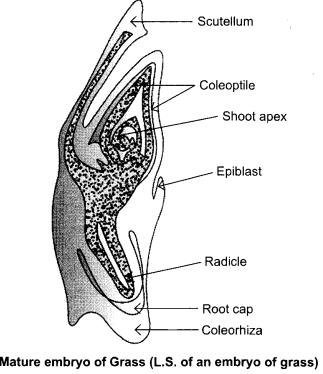
OR
- In a transverse section, a typical microsporangium appears circular in outline.
- It is generally surrounded by four wall layers—the epidermis, endothecium, middle layers, and the tapetum.
- The outer three wall layers perform the function of protection and help in dehiscence of anther to release the pollen.
- The innermost wall layer is the Tapetum. It nourishes the developing pollen grains. Cells of the tapetum possess dense cytoplasm and generally have more than one nucleus.
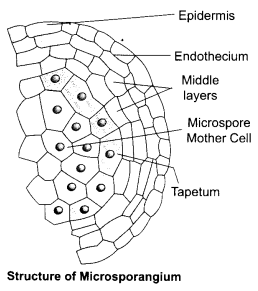
Answer 12.
Chromosomal theory of inheritance was proposed by Sutton and Boveri.
| Similarities between the behaviour of genes and that of chromosomes | |
| Behaviour of Genes | Behaviour of Chromosomes |
| 1. Occur in pairs | 1. Occur in pairs |
| 2. Segregate at the time of gamete formation such that only one of each pair is transmitted to a parent. | 2. Segregate at gamete formation and only one of each pair is transmitted to a gamete. |
Answer 13.
Pathogen – Entamoeba histolytica
Organ affected – Large intestine
Symptoms:
- Constipation
- Abdominal pain
- Cramps, stools are covered with mucous and blood clots.
Mode of Transmission: Houseflies act as mechanical carriers which transmit the parasite from the faces of infected person to the food and drinking water.
Answer 14.
Some organisms possess phenotypic adaptations which help them to respond quickly to an unfavourable situation.
For example, at high altitudes due to the low atmospheric pressure the human body does not get sufficient oxygen which causes altitude or mountain sickness characterised by nausea, vomiting and heart palpitation. The body compensates this low oxygen availability by increasing red blood cells, which decreases the binding-capacity of haemoglobin thereby increasing breathing rate.
Answer 15.
1. PCR (Polymerase Chain Reaction) is used to detect the presence of gene sequences of the infectious agents.
2. It is used to detect specific microbes from the samples of soil, sediments and water.
3. It is also used to detect HIV in AIDS patient.
Answer 16.
The three types of natural selection are as follows:
(1) Stabilizing Selection: The stabilizing influence of natural selection -in an environment changes little in space and time. It is also called maintenance evolution.
(2) Directional or Progressive Selection: Directional selection produces a regular change within a population in one direction in respect to certain characteristics.
(3) Disruptive Selection: In this original population splits into two groups which later evolved into two different species.
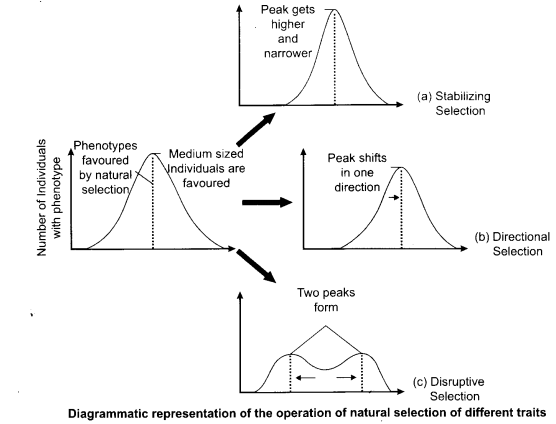
Answer 17.
In the original population of bacteria, there were some bacteria which possessed antibiotic resistant genes. When antibiotic was not used, these bacteria had no advantage with the use of antibiotics, these bacteria survived, reproduced and spread throughout the population.
Answer 18.
1. ADA is caused by the deletion of the gene responsible for the enzyme adenosine deaminase.
2. The enzyme adenosine deaminase plays crucial role in the functioning of the immune system.
3. The infusion of genetically engineered lymphocytes into the patient suffering from ADA deficiency is not a permanent cure because these cells are not immortal.
Answer 19.
(a) India has passed the Water Act in 1974. The objective of Water Act is the prevention and control of water pollution.
(b) Four problems caused due to deforestation are:
- Deforestation has enhanced CO2 level which has contributed to the greenhouse effect or global warming.
- It has caused soil erosion.
- It has disturbed the hydrological cycle or water cycle.
- It has lead to the loss of diversity.
Answer 20.
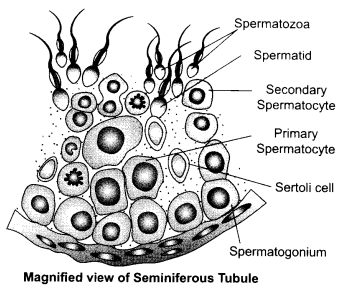
Answer 21.
(a) Two essential roles of ribosomes during translation are:
- The larger subunit of ribosome has a groove for pushing out the newly formed polypeptide and protects the same from cellular enzymes.
- The smaller unit of ribosome has a point for recognising mRNA and binding area for initiation factors.
(b) Nucleic acids were first identified by Friedrich Meischer. It was named as nucleic acids because it was isolated from the nuclei of cells.
Answer 22.
a → Ovary
b → Testis
c → Ampullary Isthmic Junction(fallopian tube)
Answer 23.
1. We can explain the villagers that vaccination is not given to cure any disease at the given time. Now they may be healthy, but when an epidemic of a disease occurs, or when they happen to encounter an infectious disease, the body does not have enough of antibodies to fight against. By vaccination, the body produces antibodies and also memory cells that can produce antibodies during an encounter with the same pathogen.
2. Advertisement propaganda can be made:
- By giving examples of cases where death has occurred due to failure of vaccination.
- Advertisement in newspapers about vaccination and its benefits.
SECTION-E
Answer 24.
(a) Coding segments in DNA are known as Exons whereas non-coding segments are known as introns.
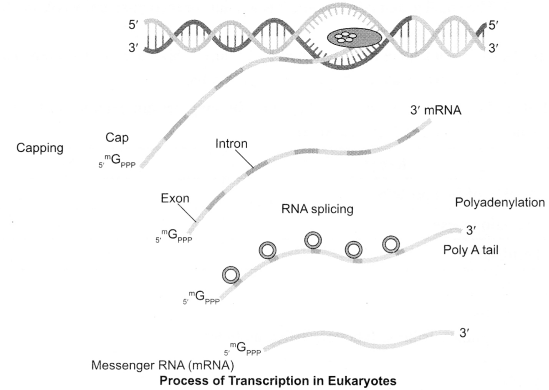
(a) BAC → Bacterial Artificial Chromosome
YAC → Yeast Artificial Chromosome
(b) Promoter initiates the process of transcription.
(c)
| Template Strand | Coding Strand |
| 1. The DNA strand having polarity 3’ → 5′ is known as template strand. |
1.The DNA strand having polarity 5′ → 3′ is known as coding strand. |
| 2. 3′ – A T G C A T G C A T G C A T G C – 5′ Template strand |
2. 5′ – T A C G T A C G T A C G T A C G – 3′ Coding strand |
Answer 25.
(a) Contact inhibition is a property by virtue of which normal cells by contact with other cells inhibit their uncontrolled growth.
(b) Harmful effects of Tobacco:
- Tobacco contains nicotine which stimulates the adrenal gland to release adrenaline and noradrenaline into blood circulation, both of which raise blood pressure and increase , heart rate.
- It is associated with increased incidence of cancers of lung, throat, urinary bladder, bronchitis, emphysema, gastric ulcer and coronary heart disease.
- Tobacco chewing is associated with increase risk of cancer of the orai cavity.
(c) Sports person often take cocaine to increase their energy level for the game because it has a potent stimulating action to provide them instant energy. With regular intake they fall victim to cocaine addiction as it acts on their nervous system producing a sense of euphoria and interferes with the transport of the nano-transmitter dopamine.
OR
Morphological and biochemical characteristics of plants associated with resistance to certain pests has been seen in many host crop plants such as:
- Hairy leaves in cotton are resistant to Jassids and cereals leaf beetle in wheat.
- In wheat solid stems lead to non-preference by the stem sawfly.
- In cotton, smooth leaved and nectar-less varieties do not attract bollworms.
- In maize, high aspartic acid, low nitrogen and sugar content leads to resistance to maize stem borers.
- Thoms in Acacia, Cactus are the most common morphological means of defence in plants
Answer 26.
(a) The outer hard layer of pollen grain called the exine is made up of sporopollenin. It can withstand the worst condition of fossilization such as high temperatures and action of strong acids and alkali.
No enzyme is so far known that can degrade sporopollenin. Pollen grains are well preserved as fossils because of the presence of sporopollenin.
(b)
1. a → exponential curve
2. b→ logistic curve
3. Since resources for growth for most animal populations are finite and will become limiting sooner or later, therefore the logistic growth model/curve is considered to be a more realistic one.
4. K — carrying capacity
5. N — Population density at time “t”
OR
(a)
1. Combustion of fossil fuels
2. Deforestation
(b) Slash and Burn cultivation or Jhum cultivation or Jhuming is a type of agriculture which is responsible for deforesation. It is technically known as shifting cultivation. In India about five lakh hectares of land is cleared every year through hopping, burning the remainder, mixing the ash with soil & sowing the cleared land with crop seeds.
We hope the CBSE Sample Papers for Class 12 Biology Paper 1 help you. If you have any query regarding CBSE Sample Papers for Class 12 Biology Paper 1, drop a comment below and we will get back to you at the earliest.